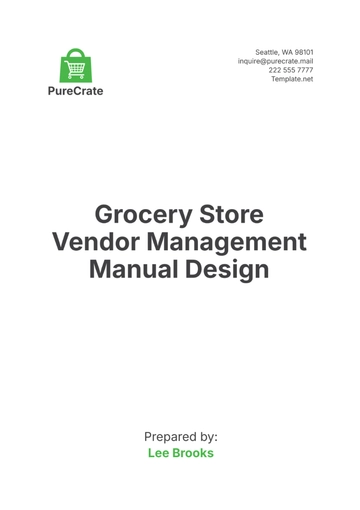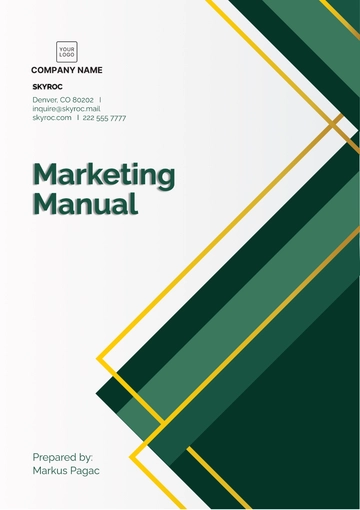Free Marketing Manual Design

Name | [YOUR NAME] |
|---|---|
Company | [YOUR COMPANY NAME] |
Department | [YOUR DEPARTMENT] |
Date | [DATE] |
I. Introduction
Welcome to the Marketing Manual provided by [YOUR COMPANY NAME]. This comprehensive manual is designed to equip you with the necessary knowledge and strategies to excel in the field of marketing. Whether you're a seasoned marketer looking to refine your skills or a newcomer eager to learn, this manual will serve as your go-to resource for understanding key concepts and implementing effective marketing strategies.
In this manual, you'll find a wealth of information covering various aspects of marketing, including [YOUR COMPANY NAME]'s approach to digital marketing, content creation, social media management, SEO techniques, and more. Each section is carefully crafted to provide you with practical insights, actionable tips, and real-world examples to help you achieve your marketing objectives.
II. Getting Started
A. About [Your Company Name]
[YOUR COMPANY NAME] is a leading provider of [PRODUCT] known for its innovative solutions and commitment to excellence. With a dedicated team of marketing professionals, we strive to [PURPOSE].
B. Objectives of this Manual
The primary objectives of this manual are to:
Provide a comprehensive overview of marketing principles and strategies.
Offer practical guidance on implementing effective marketing campaigns.
Equip marketers with the tools and knowledge needed to drive results for [YOUR COMPANY NAME].
Serve as a reference guide for ongoing marketing activities.
III. Marketing Fundamentals
A. Understanding Your Audience
One of the fundamental principles of marketing is understanding your audience. [YOUR COMPANY NAME]'s marketing efforts are tailored to meet the needs and preferences of our target audience, which includes [TARGET AUDIENCE DESCRIPTION].
To effectively engage with your audience, consider the following:
Demographic Analysis: Identify key demographic traits such as age, gender, location, income level, etc.
Psychographic Segmentation: Understand the attitudes, interests, and lifestyles of your audience.
Market Research: Conduct surveys, and interviews, and analyze data to gain insights into consumer behavior.
Buyer Personas: Create detailed profiles of your ideal customers to guide your marketing efforts.
B. Crafting Compelling Messaging
Crafting compelling messaging is essential for capturing the attention of your target audience and conveying the value proposition of your products or services. [YOUR COMPANY NAME]'s marketing messages are designed to resonate with our audience and inspire action.
Key considerations when crafting messaging include:
Unique Selling Proposition (USP): Highlight what sets your product or service apart from the competition.
Emotional Appeal: Appeal to the emotions of your audience to create a connection and drive engagement.
Clear Call-to-Action (CTA): Clearly communicate the desired action you want your audience to take.
Consistency: Ensure consistency in messaging across all marketing channels to reinforce brand identity.
Stay tuned for the next sections where we delve deeper into specific marketing strategies and tactics tailored for [YOUR COMPANY NAME]'s success.
IV. Digital Marketing Strategies
A. Search Engine Optimization (SEO)
Search Engine Optimization (SEO) plays a crucial role in improving your website's visibility and ranking on search engine results pages (SERPs). At [YOUR COMPANY NAME], we prioritize SEO to ensure our content is discoverable by our target audience.
Key elements of an effective SEO strategy include:
Keyword Research: Identify relevant keywords and phrases your audience is searching for.
On-Page Optimization: Optimize meta titles, descriptions, headers, and content for target keywords.
Content Quality: Create high-quality, informative content that provides value to users.
Link Building: Acquire backlinks from authoritative websites to improve domain authority.
Website Speed and Mobile Optimization: Ensure your website loads quickly and is mobile-friendly for a better user experience.
B. Content Marketing
Content marketing is a cornerstone of [YOUR COMPANY NAME]'s marketing strategy, aimed at attracting, engaging, and retaining our audience through valuable content. From blog posts and videos to infographics and eBooks, our content covers a wide range of topics relevant to our audience.
Key components of a successful content marketing strategy include:
Content Planning: Develop a content calendar outlining topics, formats, and publishing schedule.
Audience Segmentation: Tailor content to address the specific needs and interests of different audience segments.
Content Distribution: Promote content across various channels including social media, email newsletters, and third-party platforms.
Analytics and Optimization: Track content performance metrics such as page views, engagement, and conversions to refine your strategy over time.
Stay tuned for the next sections where we'll explore social media marketing, email marketing, and other digital marketing tactics.
V. Social Media Marketing
A. Platform Selection
Social media platforms offer diverse opportunities for engaging with your audience and promoting your brand. At [YOUR COMPANY NAME], we carefully select platforms that align with our target audience demographics and marketing objectives.
Considerations when choosing social media platforms include:
Audience Demographics: Understand which platforms your target audience frequents and tailor your presence accordingly.
Platform Features: Evaluate each platform's features and functionalities to determine which best suits your marketing goals.
Competitor Analysis: Research competitors' social media presence to identify gaps and opportunities.
Resource Allocation: Consider your team's bandwidth and resources available for managing social media accounts effectively.
B. Content Strategy
A compelling content strategy is essential for driving engagement and building a loyal following on social media. [YOUR COMPANY NAME]'s content strategy focuses on providing value, fostering community, and showcasing our brand's personality.
Elements of an effective social media content strategy include:
Content Calendar: Plan and schedule content in advance to maintain consistency and relevance.
Content Mix: Diversify content types such as images, videos, user-generated content, polls, and quizzes.
Engagement Tactics: Encourage audience interaction through likes, comments, shares, and direct messages.
Brand Voice: Define your brand's tone and personality to ensure consistency across social media channels.
As you embark on your social media marketing journey, remember to monitor performance metrics and adjust your strategy based on the insights gathered.
VI. Email Marketing
A. Building an Email List
Email marketing remains a powerful tool for nurturing leads, driving conversions, and fostering customer loyalty. At [YOUR COMPANY NAME], we prioritize building and maintaining a robust email list comprised of engaged subscribers who have opted in to receive communications from us.
Strategies for growing your email list include:
Website Opt-In Forms: Place opt-in forms strategically on your website to capture visitor email addresses.
Lead Magnets: Offer valuable resources such as eBooks, guides, or webinars in exchange for email sign-ups.
Social Media Promotion: Promote email subscriptions on your social media channels to reach a wider audience.
Contests and Giveaways: Run contests or giveaways that require participants to subscribe to your email list for entry.
B. Email Campaigns
Effective email campaigns are tailored to the needs and preferences of your audience, delivering relevant content at the right time. [YOUR COMPANY NAME]'s email campaigns are designed to provide value, whether through educational content, promotional offers, or personalized recommendations.
Components of successful email campaigns include:
Segmentation: Divide your email list into segments based on demographics, behavior, or purchase history for targeted messaging.
Personalization: Address subscribers by name and tailor content to their interests and past interactions with your brand.
Compelling Subject Lines: Craft subject lines that grab attention and entice recipients to open your emails.
Clear Call-to-Action (CTA): Clearly communicate the desired action you want recipients to take, whether it's making a purchase, signing up for an event, or downloading a resource.
By implementing these strategies, you can maximize the effectiveness of your email marketing efforts and drive meaningful results for [YOUR COMPANY NAME].
VII. Performance Tracking and Analytics
A. Key Performance Indicators (KPIs)
Tracking key performance indicators (KPIs) is essential for measuring the success of your marketing efforts and identifying areas for improvement. [Your Company Name] focuses on monitoring KPIs that align with our overarching marketing objectives and contribute to our business goals.
Common marketing KPIs to track include:
Conversion Rate: Measure the percentage of website visitors who take a desired action, such as making a purchase or filling out a form.
Customer Acquisition Cost (CAC): Calculate the cost of acquiring a new customer, including marketing expenses.
Return on Investment (ROI): Assess the profitability of marketing campaigns by comparing the revenue generated to the cost of investment.
Click-Through Rate (CTR): Evaluate the effectiveness of digital advertising and email campaigns by measuring the percentage of clicks relative to impressions.
Engagement Metrics: Track metrics such as likes, shares, comments, and retweets to gauge audience engagement on social media.
B. Analytics Tools
To effectively track and analyze marketing performance, [YOUR COMPANY NAME] leverages a variety of analytics tools and platforms. These tools provide valuable insights into audience behavior, campaign effectiveness, and website performance, enabling us to make data-driven decisions and optimize our marketing strategies.
Popular analytics tools used by [YOUR COMPANY NAME] include:
Google Analytics: Provides in-depth insights into website traffic, user behavior, and conversion metrics.
Social Media Analytics: Platforms such as Facebook Insights, Twitter Analytics, and LinkedIn Analytics offer data on audience demographics, engagement, and content performance.
Email Marketing Platforms: Tools like Mailchimp, Constant Contact, and HubSpot provide analytics on email open rates, click-through rates, and subscriber engagement.
Advertising Platforms: Platforms like Google Ads, Facebook Ads, and LinkedIn Ads offer detailed metrics on ad performance, including impressions, clicks, and conversions.
By regularly analyzing these metrics and adjusting our strategies accordingly, we can optimize our marketing efforts and drive continuous improvement.
VIII. Conclusion
In summary, the Marketing Manual provided by [YOUR COMPANY NAME] offers a comprehensive roadmap for success in digital marketing. By following the strategies outlined in this manual, you can effectively reach and engage your target audience while driving meaningful results for your business. Thank you for choosing [YOUR COMPANY NAME] as your partner in marketing excellence.
- 100% Customizable, free editor
- Access 1 Million+ Templates, photo’s & graphics
- Download or share as a template
- Click and replace photos, graphics, text, backgrounds
- Resize, crop, AI write & more
- Access advanced editor
Discover the ultimate marketing companion with Template.net's Marketing Manual Template. Crafted for efficiency, this editable and customizable tool empowers your brand strategy. Seamlessly tailored to your needs, it's effortlessly editable in our Ai Editor Tool. Elevate your marketing prowess today with this indispensable resource.





























